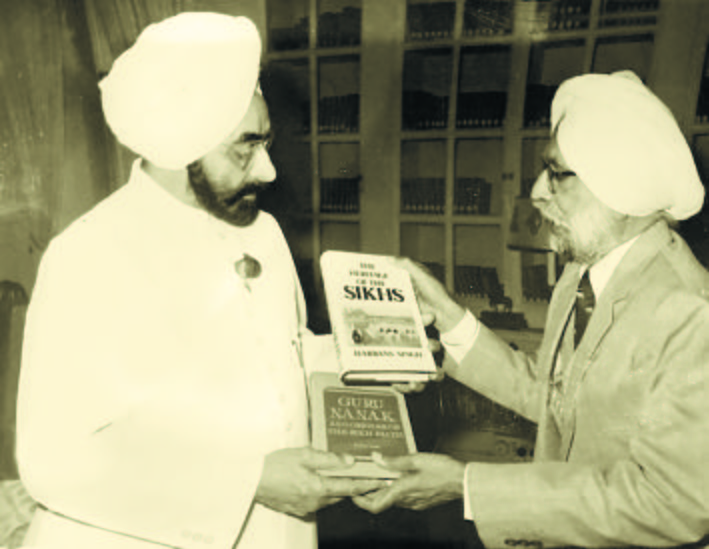
Prof Harbans Singh (right) with President Giani Zail Singh. - File photo
Rupinder Singh Brar
Popular perceptions being what they are, scholarship is not something that comes easily to mind when one considers the Sikh community. Yet, the community has produced some notable historians who not only left behind rich literary legacies, but exemplified in their personal lives what it meant to be a scholar sage. For example, in the 17th century, it was Bhai Gurdas, in the 18th Bhai Mani Singh, in the 19th it was Bhai Kahan Singh Nabha and Bhai Vir Singh and in the 20th, several names come to mind. Prominent among them is Professor Harbans Singh, whose birth centenary falls on March 6.
Born in the village of Kotha Guru in Bathinda district, Prof Harbans Singh rubbed shoulders with intellectual giants like Wilfred Cantwell Smith of Harvard, yet carried himself with such casual grace that he left a lasting impression on all whom he met. Said a Canadian scholar once, "To know such a person is to emerge a bigger, better person oneself.”
An embodiment of Nanakian virtue, his best lessons were delivered not through seminars or books but through example. When SGPC president Gurcharan Singh Tohra, together with Parkash Singh Badal, honoured him with a cheque for Rs 25,000, not a small amount in those days, he refused to accept any money, insisting that it be used for promoting Sikh studies instead.
A prodigious mind, his first major university appointment came as head of the department even before he was quite 23. His heart, however, lay in scholarship, not administration. In 1966, he produced his first major work in English, a definitive biography of Guru Gobind Singh. Not only was the book translated into most Indian languages, its Sanskrit translation won the coveted Sahitya Akademi award. Three years later, he produced a biography of Guru Nanak. It was another major achievement. The Times Literary Supplement, London, called the book, ‘Guru Nanak and the Origins of the Sikh Faith’, “the best short study of Guru Nanak’s life, and an outstanding example of modern Sikh scholarship”.
More similar works followed. He travelled extensively, lecturing in Japan, Belgium, the Netherlands, England, Ireland, and the USA. Most men would rest comfortably upon such laurels, but not him. In 1972, he set out to produce an encyclopedia of Sikhism. It was an unbelievably ambitious goal, even for him. There were many sceptics. Wrote Khushwant Singh, “I do not know where he will find 4,000 contributors who have the discipline required to write factual, accurate and unbiased pieces in the exact number of words prescribed.”
Undaunted, Harbans Singh created a team of writers and researchers around him. He painstakingly collected and reviewed every paper, artifact, and bit of data, then edited and reduced all information into concise entries. Months turned to years and years to decades as the work stretched into the late 1990s, and yet he toiled away doggedly. Impressed, the academic and the lay communities finally took notice. Guru Nanak Dev University awarded him an honorary doctorate. The SGPC bestowed upon him a special award. By now, even Khushwant Singh had become an admirer. “A start has been made at Patiala to produce the Encyclopedia of Sikhism,” he wrote. “Harbans Singh… its editor-in-chief, is the right man for the job. How many professors are there who turn down offers of Vice-Chancellorships? Harbans Singh refused one that was offered to him on a platter.”
It was true, but by then the Professor had sacrificed much more than a prestigious post in his magnificent obsession. Despite suffering a paralytic stroke and losing his loving wife, he slogge d on relentlessly. He breathed his last on May 30, 1998, literally days after completing his monumental work. He was gone but his legacy was secure. Later that year, the Prime Minister himself would release four volumes.
Recognitions continued posthumously. In 1999, he was awarded the ‘Order of the Khalsa’ by the community and later still Punjabi University created a full-fledged Department in his name. However, the highest homage came from another, more familiar source. In 2019, another historian, Prof Nikky Guninder Kaur Singh, his daughter, came out with a book on Guru Nanak — a fitting tribute to a worthy father.
The writer is a practising physician in Yuba City, California
Join Whatsapp Channel of The Tribune for latest updates.



























